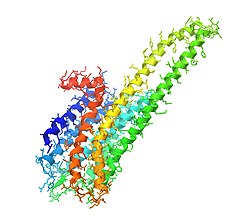
Back مستقبل 5-HT2A Arabic مستقبل 5 HT2A ARZ HTR2A BS HTR2A Welsh Receptor 5-HT2A Spanish Receptorium serotonini 2A Latin Receptor 5-HT2A Polish Receptor 5-HT2A Portuguese 5-HT2A-рецептор Russian 5-HT2A receptor Serbo-Croatian
The 5-HT2A receptor is a subtype of the 5-HT2 receptor that belongs to the serotonin receptor family and functions as a G protein-coupled receptor (GPCR).[4] It is a cell surface receptor[5] that activates multiple intracellular signalling cascades.[6] Like all 5-HT2 receptors, the 5-HT2A receptor is coupled to the Gq/G11 signaling pathway. It is the primary excitatory receptor subtype among the serotonin-responsive GPCRs. The 5-HT2A receptor was initially noted for its central role as the primary target of serotonergic psychedelic drugs such as LSD and psilocybin mushrooms. It later regained research prominence when found to mediate, at least in part, the effects of many antipsychotic drugs, particularly atypical antipsychotics.
Downregulation of post-synaptic 5-HT2A receptors is an adaptive response triggered by chronic administration of selective serotonin reuptake inhibitors (SSRIs) and atypical antipsychotics. Elevated 5-HT2A receptor density has been observed in suicidal and otherwise depressed patients, suggesting that post-synaptic 5-HT2A receptor overexpression may contribute to the pathogenesis of depression.[7] Paradoxically, several 5-HT2A receptor antagonists can also induce receptor downregulation.[8] This effect may lead to reverse tolerance, rather than the expected development of tolerance. However, at least one antagonist has been shown to upregulate 5-HT2A receptor expression,[8][9] and a few others appear to have no effect on receptor levels.[10] Nonetheless, such upregulation remains the exception rather than the rule.
Importantly, neither tolerance nor rebound has been observed in humans in relation to the slow-wave sleep (SWS)-promoting effects of 5-HT2A antagonists.[11]
- ^ a b c GRCh38: Ensembl release 89: ENSG00000102468 – Ensembl, May 2017
- ^ "Human PubMed Reference:". National Center for Biotechnology Information, U.S. National Library of Medicine.
- ^ "Mouse PubMed Reference:". National Center for Biotechnology Information, U.S. National Library of Medicine.
- ^ Cook EH, Fletcher KE, Wainwright M, Marks N, Yan SY, Leventhal BL (August 1994). "Primary structure of the human platelet serotonin 5-HT2A receptor: identify with frontal cortex serotonin 5-HT2A receptor". Journal of Neurochemistry. 63 (2): 465–469. doi:10.1046/j.1471-4159.1994.63020465.x. PMID 8035173. S2CID 40207336.
- ^ Kling A (2013). 5-HT2A: a serotonin receptor with a possible role in joint diseases (PDF) (Ph.D. thesis). Umeå, Sweden: Umeå Universitet. ISBN 978-91-7459-549-9.
- ^ Raote I (2007). "Serotonin 2A (5-HT2A) Receptor Function: Ligand-Dependent Mechanisms and Pathways". Ishier. Frontiers in Neuroscience. Press/Taylor & Francis. ISBN 9780849339776. PMID 21204452.
- ^ Eison AS, Mullins UL (1996). "Regulation of central 5-HT2A receptors: a review of in vivo studies". Behavioural Brain Research. 73 (1–2): 177–181. doi:10.1016/0166-4328(96)00092-7. PMID 8788498. S2CID 4048975.
- ^ a b Yadav PN, Kroeze WK, Farrell MS, Roth BL (October 2011). "Antagonist functional selectivity: 5-HT2A serotonin receptor antagonists differentially regulate 5-HT2A receptor protein level in vivo". The Journal of Pharmacology and Experimental Therapeutics. 339 (1): 99–105. doi:10.1124/jpet.111.183780. PMC 3186284. PMID 21737536.
- ^ Rinaldi-Carmona M, Congy C, Simiand J, Oury-Donat F, Soubrie P, Breliere JC, et al. (January 1993). "Repeated administration of SR 46349B, a selective 5-hydroxytryptamine2 antagonist, up-regulates 5-hydroxytryptamine2 receptors in mouse brain". Molecular Pharmacology. 43 (1): 84–89. doi:10.1016/S0026-895X(25)13451-2. PMID 8423772.
- ^ Gray JA, Roth BL (November 2001). "Paradoxical trafficking and regulation of 5-HT(2A) receptors by agonists and antagonists". Brain Research Bulletin. 56 (5): 441–451. doi:10.1016/s0361-9230(01)00623-2. PMID 11750789. S2CID 271925.
- ^ Vanover KE, Davis RE (28 July 2010). "Role of 5-HT2A receptor antagonists in the treatment of insomnia". Nature and Science of Sleep. 2: 139–150. doi:10.2147/nss.s6849. PMC 3630942. PMID 23616706.
© MMXXIII Rich X Search. We shall prevail. All rights reserved. Rich X Search




